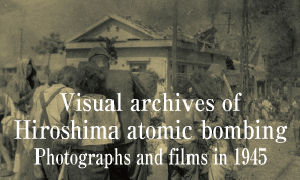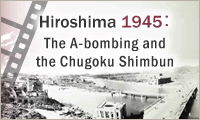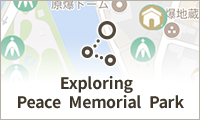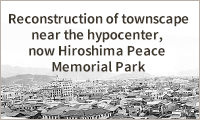Total of 83 residents and workers of five businesses in former Motoyanagi-machi died by end of 1945
May 8, 2000
On May 7, in cooperation with the bereaved families of those who died in the bombing, and others, the Chugoku Shimbun compiled information on how the residents and workers in Motoyanagi-machi (today’s Nakajima-cho), a district destroyed by the atomic bomb on August 6, 1945, and now part of Peace Memorial Park in Naka Ward, Hiroshima, died due to the atomic bombing. Of the 81 people from 28 households confirmed to have been living in the district at the time, 62 residents, or 77 percent of the total, including the 53 who died on the day of the bombing, died by the end of August. The deaths of five evacuated residents and 16 people working at five businesses in the district were also confirmed, bringing the total number of deaths caused by the atomic bombing to 83 by the end of 1945.
Motoyanagi-machi was a small block of about 40 houses and businesses, facing the left bank of the Honkawa River that runs alongside Peace Memorial Park. It was home to textile wholesalers and inns, forming a corner of the bustling downtown of the delta.
The survey was conducted based on information from members of “Ryuseikai” (represented by Ryozo Ueda), an association composed of a small number of former residents of Motoyanagi-machi, who know the whereabouts of bereaved families of former residents. Information obtained from surveys of A-bombed residents of Nakajima-honmachi and Zaimoku-cho, districts next to Motoyanagi-machi, was also used when those involved were searched.
Of the 62 residents, 43 are believed to have been exposed to the bombing at home and died by August 20, while the remaining 19 were exposed outside the district, including at their mobilized sites, and died by August 28. In six households, excluding single-person households, the entire family was killed. The highest number of victims per household was five, in two households.
At least 16 employees of five businesses in the area died, and except for one who died in September, they all either died in the atomic bombing or their final moments are unknown.
According to records from the Hiroshima branch of Morinaga Shokuryo Kogyo KK. (now Morinaga & Co., Ltd.), whose foundations were unearthed in February of this year from under the ground in the former Motoyanagi-machi district, 22 of its employees (two of the names were unknown) had died in the bombing. The survey revealed the situation of 12 employees at the time of the bombing and identified one name previously unknown.
(Originally published on May 8, 2000)
Motoyanagi-machi was a small block of about 40 houses and businesses, facing the left bank of the Honkawa River that runs alongside Peace Memorial Park. It was home to textile wholesalers and inns, forming a corner of the bustling downtown of the delta.
The survey was conducted based on information from members of “Ryuseikai” (represented by Ryozo Ueda), an association composed of a small number of former residents of Motoyanagi-machi, who know the whereabouts of bereaved families of former residents. Information obtained from surveys of A-bombed residents of Nakajima-honmachi and Zaimoku-cho, districts next to Motoyanagi-machi, was also used when those involved were searched.
Of the 62 residents, 43 are believed to have been exposed to the bombing at home and died by August 20, while the remaining 19 were exposed outside the district, including at their mobilized sites, and died by August 28. In six households, excluding single-person households, the entire family was killed. The highest number of victims per household was five, in two households.
At least 16 employees of five businesses in the area died, and except for one who died in September, they all either died in the atomic bombing or their final moments are unknown.
According to records from the Hiroshima branch of Morinaga Shokuryo Kogyo KK. (now Morinaga & Co., Ltd.), whose foundations were unearthed in February of this year from under the ground in the former Motoyanagi-machi district, 22 of its employees (two of the names were unknown) had died in the bombing. The survey revealed the situation of 12 employees at the time of the bombing and identified one name previously unknown.
(Originally published on May 8, 2000)






